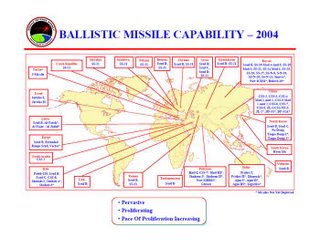"Every test has failed." News to me!
 C.I.R. Press Editorial
C.I.R. Press EditorialUNDISCLOSED – This post is another in what I foresee as a series of pieces about Missile Defense. No, I am not going to argue the cost of the system because I think it is a high priority and should be on the front burner and get the attention it deserves. I am sure there will be replies saying it is too expensive and that is fine. I am not debating the cost… DoD programs in development are very expensive.
Rob and others have done a good job at putting budget numbers up to try and cement their stance. That is fine, this is my response to those that don’t debate the facts or cost but simply hide behind the uniformed and ignorant line of “every test has failed.” No they have not And this LONG piece is the proof.
“In laying out this picture of the threat our nation faces, I’m reminded of the observation of the Marquis of Salisbury: ‘If you believe the doctors, nothing is wholesome; if you believe the theologians, nothing is innocent; if you believe the soldiers, nothing is safe.’ To extend this to the context of missile defense, let me go two further: If you believe our missile defense critics, nothing will work. If you believe passionate advocates, we can do it tomorrow.”
“The first systems we will deploy provide close-in defense to intercept a short-range missile in its terminal phase. These include the Army’s PAC-3, expected to be operational later this year.”
“Currently we have a small, 120 pound kill vehicle with its own guidance and sensing system. Once lifted into space and pointed in the right direction, on its final leg, it can steer itself into the target and obliterate the warhead by violent impact… This is called hit-to-kill — hitting a bullet with a bullet. Traditional explosives don’t work well in space, and the nuclear tipped interceptors on which we relied 25 years ago — and on which the Russians still rely — have major political and operational drawbacks.”
“We’ve achieved success with hit-to-kill not once, but seven times out of the last ten attempts in the past two years, with three different systems. … Our NMD program, for example, has had one hit followed by two well-publicized failures in our three intercept flight tests so far.
I relearned a basic truth in missile defense: that success occurs in private and failure in full view. That they were well publicized is an understatement. Despite our high profile failures, we have made significant progress in developing this system.”
“This is rocket science, and it is difficult, but not impossible. Seven hundred years ago, the current wisdom held that sailors who ventured too far from land would fall off the edge of the Earth. Columbus proved them wrong. Seventy years ago, naysayers were saying that rockets wouldn’t work in space because there was no air to push against. Robert Goddard proved them wrong. Seven years ago, critics were still saying we couldn’t hit a missile in space. We’ve done it. Now they say, ‘OK, you can hit it. But it will be fooled by decoys and countermeasures, so you shouldn’t build it.’"
Lt. General Ronald Kadish, USAF
March 2, 2001
List of tests
Nov 30, 1993 : The Army carried out a successful test of the Extended Range Interceptor. The ERINT collided with the warhead of a STORM target vehicle. This warhead contained a cluster of 38 pressurized, water-filled containers designed to simulate toxic chemical submunitions.
Feb 15, 1994 : An Extended Range Interceptor (ERINT) hit a ballistic missile target vehicle in a test. The target was a nose cone carrying a simulated chemical warhead.

Jan 24, 1997 : A modified Standard Missile 2 Block IVA successfully intercepted and destroyed a Lance missile target. During the test, the interceptor successfully transitioned from radar guidance to its infrared guidance system prior to destroying the target with its blast fragmentation warhead.
Feb 7, 1997 : BMDO and the U.S. Army's Space and Strategic Defense Command carried out a test in which a Patriot Advanced Capability-2 (PAC-2) missile successfully intercepted a theater ballistic target missile. The target missile was fired from Bigen Island, Aur Atoll, toward the Kwajalein Atoll; the interceptor missile was fired from Meck Island in the Kwajalein Atoll and intercepted the target missile over the Pacific Ocean. A Patriot Guidance-Enhanced Missile was also fired at the target, but destroyed itself because the PAC-2 missile had already destroyed the target missile. The target missile had the characteristics of a variant of the Scud missile.
May 12, 1998 : (Failure. But note that some excess costs by such failures were picked up by L-M.)This was the fifth straight failure to intercept for THAAD. The fourth failure earlier had triggered major concern about the program… [resulting in] an agreement with Lockheed-Martin whereby the company would pay the government as much as a total of $75 million in case of later failures in the test program.
Mar 15, 1999 : BMDO and the U.S. Army conducted the Patriot Advanced Capability-3 missile Seeker Characterization Flight (SCF) test. Preliminary data indicated that the test was successful. The objectives of the test included collecting data and analyzing the system/missile capability to detect, track, and close with its target, gathering data on the PAC-3 missile seeker in a flight environment, and evaluating performance closed-loop homing guidance in flight. While interception was not a specific objective of the SCF, the PAC-3 missile did intercept the Hera target missile.
Jun 10, 1999 : THAAD successfully intercepted a Hera target missile. This test ended a string of six failures.
Aug 2, 1999 : The 11th flight test for the Theater High Altitude Area Defense (THAAD) defense missile system was completed successfully, when the THAAD interceptor struck a Hera target missile. For the first time in FT-11, THAAD intercepted a target outside the earth's atmosphere. This was also the missile's first intercept of a warhead that had separated from its booster. The difficulty of the test was further increased because cooling of the target in outer space reduced the ability of the missile's infrared sensors to detect it.
Sep 16, 1999 : The Ballistic Missile Defense Organization and the U.S. Army today conducted a successful intercept test of the PATRIOT Advanced Capability-3 (PAC-3) missile. Test objectives included a body-to-body intercept of a threat representative of a tactical ballistic missile target; a demonstrated capability of the ground system and missile to detect, track, and engage the target, and to collect data to evaluate missile homing functions.
Oct 2, 1999 : BMDO and the U.S. Army Space and Missile Defense Command successfully carried out the IFT-3 NMD test. A modified Minuteman intercontinental ballistic missile (ICBM) target vehicle was launched from Vandenberg AFB, California; and a prototype NMD interceptor was launched approximately 20 minutes later and 4,300 miles away from the Kwajalein Atoll in the Republic of the Marshall Islands. The intercept occurred at approximately 7:32 p.m. PDT and demonstrated the ability of the exoatmospheric kill vehicle to intercept and destroy a ballistic missile target outside the atmosphere. The intercept vehicle weighed about 120 pounds and was equipped with two infrared sensors, a visible sensor, and a small propulsion system. The interceptor's seeker system located and tracked the target and then guided the kill vehicle to a body-to-body impact with the target. The test demonstrated the power of a "hit to kill" interceptor to totally destroy and neutralize a warhead carrying a weapon of mass destruction-nuclear, chemical or biological.
Feb 5, 2000 : A PAC-3 missile successfully intercepted its Hera target. The Hera had been launched from Fort Wingate about five minutes before the launching of the Patriot.
Mar 15, 2000 : The Army completed flight test MFT-3B. In this test, a PAC-2 production missile was fired from a PAC-3 launcher and "successfully engaged" a target that was towed behind a MQM-107 drone. The purpose of this test was to "demonstrate the ability to launch a standard Patriot missile from a PAC-3 launcher and collect reliability data on the production missile round."
Oct 14, 2000 : The Ballistic Missile Defense Organization and the U.S. Army completed Development Test-6 (DT-6) in the Patriot program. This was a complex test involving three targets and two interceptor missiles. The test entailed a simultaneous engagement using a PAC-3 and a PAC-2 missile and two targets, one a ballistic missile, the other an air-breathing drone. One of the principal objectives of the test was to demonstrate system capability to engage and destroy a maneuvering tactical ballistic missile reentry vehicle with a PAC-3 missile and a sub-scale air-breathing target with a PAC-2 missile. The test also aimed to demonstrate PAC-3 seeker acquisition and tracking of a target with a second object present in the seeker's field of view. The targets used in the test were a tactical ballistic target (STORM) and an MQM-107 drone (two drones were actually launched although only one was targeted). During this highly successfully test the PAC-3 missile intercepted and destroyed the STORM target. While the PAC-2 missile did not destroy its sub-scale drone target (MQM-107), the drone did appear to be damaged.
Oct 19-21, 2001 : A poll conducted during this period by the Gallup Organization showed that 70% of the American people favored spending the money needed to build a missile defense system. This was up from 53% in a 14-16 July poll.
Dec 3, 2001 : BMDO and the U.S. Army successfully completed Integrated Flight Test 7 (IFT-7) in the Ground-Based Midcourse Segment portion of the overall missile defense program. This was two straight successes and brought the count in the intercept test series to three successes out of five attempts.
Jun 23, 2004 : In a Missile Defense Agency radar test, an Aegis destroyer, the USS Paul Hamilton detected and tracked the flight of the unarmed Air Force intercontinental ballistic missile after it was launched from Vandenberg Air Force Base in California. The ship-based radar passed data about the in-flight ballistic missile to the Ballistic Missile Defense command and control center at the Joint National Integration Center in Colorado, marking the first time a Navy ship equipped with advanced Aegis radar and a ground missile defense system has successfully passed information about a missile. The ship detected the friendly missile when it came above horizon and tracked it for about 700 miles. The test was an important step in linking the entire missile defense system together.
Jul 29, 2004 : An Arrow missile successfully intercepts a ballistic missile target off the California Coast. The test was part of the joint U.S. - Israeli Arrow System Improvement Program.
Sep 2, 2004 : The Army successfully conducts a flight test of the PATRIOT Advance Capability-3 (PAC-3). The test demonstrated the systems capability to track, engage and intercept a short-range tactical ballistic missile and a low-altitude cruise missile target. A THAAD radar system was used to track the targets during the test.
 And ballistic missile defense is not needed?
And ballistic missile defense is not needed?If every test has failed, how am I able to provide over 10 examples of success? And those are the tests in public knowledge. Those show the specific interception tests, none of the ground, simulation, or just flight tests.
-md
Also reference: Innovation and the BMDS.
Technorati Tags: nuclear, missile defense, BMDS, BMDO
Labels: MDA, missile defense






<< Home